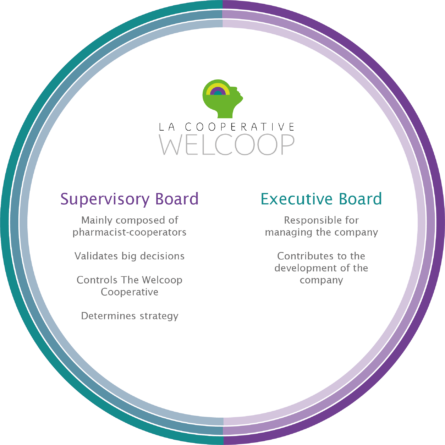A governance shared with pharmacists

The cooperative is a democratic model which respects above all the human experience and the quality of relationships, while still striving for economic viability.
Since 1971, governance of The Cooperative has been shared between two complementary entities in constant dialog: the Supervisory Board and the Executive Board. Its economic and relational model is backed by rules to ensure an equitable division of risks and of value produced.
The governance of
The Welcoop Cooperative
- The Supervisory Board
- Mainly composed of pharmacist-cooperators
- Validates big decisions
- Controls The Welcoop Cooperative
- Determines strategy
- The Executive Board
- Responsible for managing company
- Contributes to the development of the company

The Supervisory Board
It is composed of 11 cooperator pharmacists, 1 member of the Cooperation Board and one employee of the Group. It continuously verifies the actions of the Executive Board, whose members it nominates. In order for this to take place, the members of the Supervisory Board and of the Executive Board meet at least 6 times a year. The Executive Board informs the Supervisory Board about budgets, activity and actions of all the subsidiary businesses of the Welcoop Group. Together, they define the strategic orientations of the Group.

The Executive Board
Composed of Management and operational specialists in their areas of expertise, the role of the Executive Board is to ensure that The Cooperative and its subsidiaries work well, and to determine their strategy. It creates a synergy of the strategic and operational objectives of each subsidiary and determines how best to achieve them. This management framework for attaining expected performance within allocated means is indispensable, to avoid risk and respect rules which aim to create and share value.


Strategic Oversight Committees
Since 2018, in keeping with group strategy, the “Patient Centric” and “Network” oversight committees meet monthly. Each committee is composed of members of each relevant subsidiary, thus allowing a significant interaction with, and ownership of, key subjects. The quality of relationships between stakeholders is essential. It gives them a sense of responsibility and protects their interests. The closeness of each member to their customers influences their ability to detect their needs, and thus, to roll out and consolidate new strategic directions.